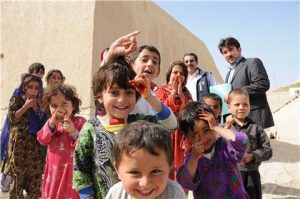The Polio ‘Endgame’
Strategic vision for lasting polio-free world published in New England Journal of Medicine.

16 June – Progress achieved over the past 12 months, since the launch of the Global Polio Eradication Initiative (GPEI) Strategic Plan 2010-2012, shows that interruption of wild poliovirus (WPV) transmission globally is a realistic goal in the near term. And while substantial challenges remain, preparation for the polio ‘endgame’ has to be intensified, to ensure that a lasting polio-free world can be realized for the post-eradication era.
This week, the New England Journal of Medicine has published a vision for the post-eradication era. Authored by Bruce Aylward, World Health Organization Assistant Director-General and Tachi Yamada, President of the Global Health Program at the Bill & Melinda Gates Foundation, the article is entitled ‘The Polio Endgame’ and outlines the strategic direction the GPEI is taking to prepare for the management of post-eradication risks.
“Preventing new polio outbreaks in a ‘post-eradication era’ will require more than bio-containment measures,” the article states. “It will eventually require stopping routine immunization with oral polio vaccine (OPV) and eliminating vaccine-derived polioviruses (VDPVs).” Since 1999, increasing scientific data demonstrate that eradicating all polio diseases will require the eventual cessation of OPV in routine immunization programmes; otherwise the continued routine reintroduction of the attenuated polioviruses of OPV into a polio-free world will result in polio cases due to vaccine-associated paralytic polio (VAPP), and could generate new polio outbreaks due to circulating cVDPVs.
Stopping routine immunization with OPV globally after WPVs have been eradicated will eliminate VAPP immediately and halt the generation of new circulating VDPVs. And crucially, tools are already being put in place to effectively manage the critical transition period following synchronized OPV cessation, to when any residual VDPVs (from prior to OPV cessation) have been eliminated. These tools include monovalent OPVs for each poliovirus serotype, low-cost solutions that enable low income countries to use inactivated polio vaccine (IPV) for routine immunization if needed, and antivirals.
Individually, none of these tools are perfect, requiring their coordinated use to effectively manage post-eradication risks and enable a safe cessation of OPV in routine immunization programmes. The GPEI is currently developing a new, updated ‘Roadmap for cVDPV Elimination’ that will consolidate new information on post-eradication risks and tools into the emerging strategy and timeline for post-eradication risk management. This roadmap will be regularly updated, as new information becomes available and new policies are completed, to keep policy makers at the global, regional and country levels abreast of major developments in this area.













